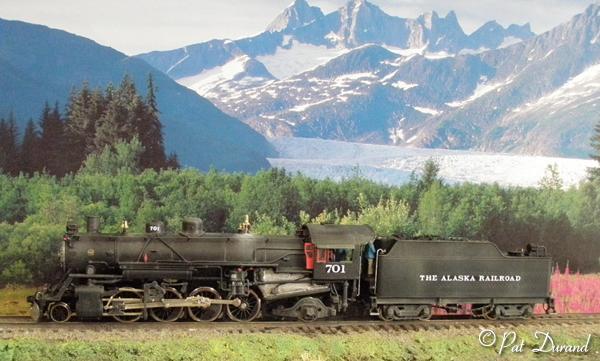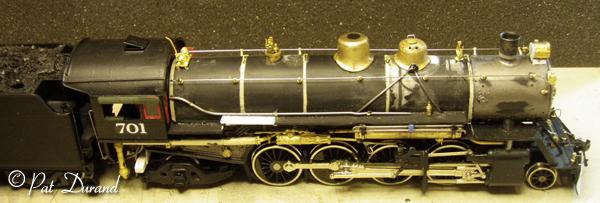Pat Durand's #701 circa 1930
Photos and text by Patrick Durand
Pat Durand's #701 circa 1930
Photos and text by Patrick Durand
701 was the first of three Mikado locomotives in the 700 class on the Alaska Railroad. Builders # 59605 was delivered new in 1926 she saw service over the entire line until retirement in 1954.

Delivered with a rear truck booster engine and a standard cab she changed
dramatically over the years and those
changes will be reflected in future
models of 702 and 703 to represent the service life of the class in Alaska.
The project began with an Athearn Genesis Mike 2-8-2. The domes were stripped, running boards and cab removed and then the wagon top boiler contour sanded down on my belt sander until the wagon top was gone along with the domes. Hint, save yourself a lot of trouble by wrapping everything that stays in blue painters tape. You will find the recess in the boiler in front of the cab will be a good guide for this operation. Cut all the windows and doors into the cab per photos. Reposition the running boards with modifications and make or acquire new domes.
The unpainted photos show most of the additions and application of brass parts listed below. Unseen is the nearly three ounces of lead added to the loco in addition to the brass parts. Lead was added to the inside of the cab roof, on the bottom of the lead truck and between the frame rails and inside the cylinder block up front and to the bottom of the cover plate holding the drivers in. More lead went under the cab to simulate an ash pan and inside the rear truck to simulate the booster engine. The air tanks are filled with lead as are the replacement domes.
The front truck got 33" 9 spoke wheels and a set of flangers added to the modified truck frame. The Athearn rear truck was modified with the addition of bits of styrene and lead into a Commonwealth style truck with booster engine. Precision Scale truck rockers were fixed into the rear frame of the truck and a new styrene waist sheet and cradle cross member built to match. Tender truck side frames are castings I made from one master I made to match the photos. These are thin applications glued to the sides of a plastic truck that has been filed flat, All wheel pickup is made by adding wiper contacts to the back of all tender wheels.
 |
 |
ICC 2000, also known as tire glue, was used almost exclusively in the building of this model. It matches the black color of the model base material and cures instantaneously with application of accelerator. It is strong, flexible and will hold just about anything together. I use it as a filler for plugging holes as well.
Baker valve gear was used on all of The Alaska Railroad big power when purchased new. I made the plunge by cutting off all offending parts of the Walsharts gear on the Athearn model and then applied new brackets made from styrene and brass to simulate the Baker Gear as shown here. It worked so well I may back shop my Pacific and the 801 for the same conversion. Think I will wait until they need boiler work.

If you plan to work your locomotive then purchase and install the Northwest Short line gear set:
Believe me after you have made all these additions and modifications you do not want to take it apart to replace gears later.
Lighting is provided by LED lamps with built in bridge rectifiers and resistors for long life and cool operation. The Soundtraxx Tsunami DCC package fits in the tender with a large speaker enclosure under the coal load. The Tender is permanently coupled to the locomotive but can be disconnected if you remove the tender tank and unplug the reverse light and the speaker.
She sounds great, works hard and is a close representation of locomotive 701 as of 1930. The length, profile and wheel base measurements are very close. The drivers are 60" on the model or 6 inches larger than the 54" on #701. Another fun project in the mission to build one loco of each class in each paint scheme on the Alaska Railroad roster. -- Pat Durand
Parts list for ARR 701 as built in 1926
Detail Associates
Precision Scale
North West Short line
Cary
Miniatures by Eric